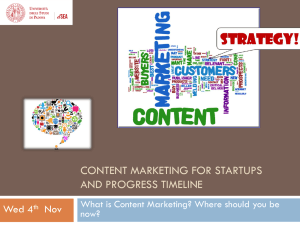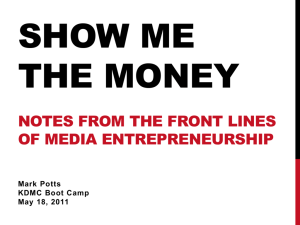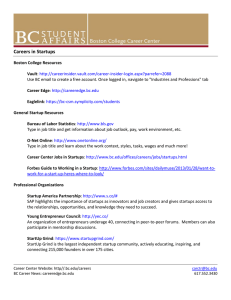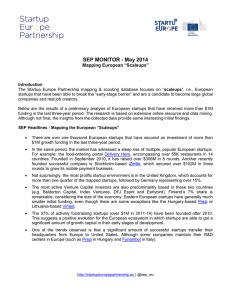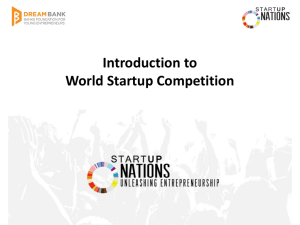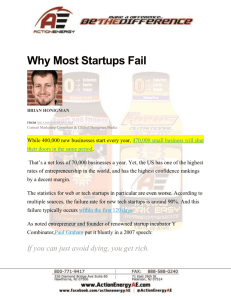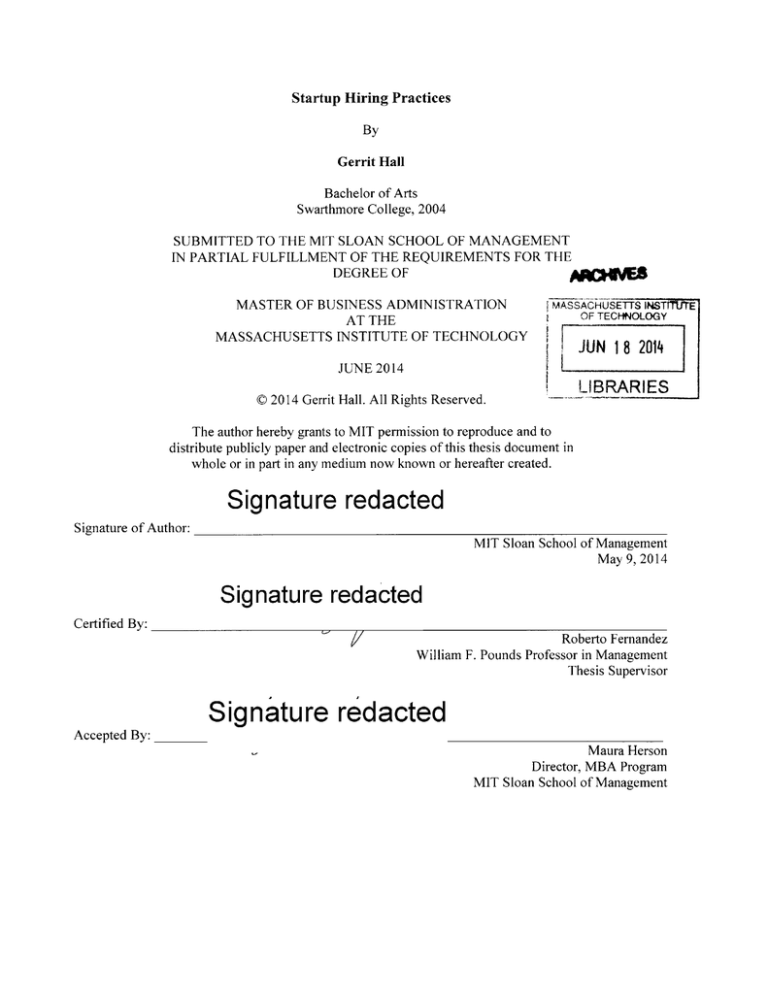
Startup Hiring Practices
By
Gerrit Hall
Bachelor of Arts
Swarthmore College, 2004
SUBMITTED TO THE MIT SLOAN SCHOOL OF MANAGEMENT
IN PARTIAL FULFILLMENT OF THE REQUIREMENTS FOR THE
DEGREE OF
MASTER OF BUSINESS ADMINISTRATION
1MASSACHUSETTS INSTIAE
AT THE
MASSACHUSETTS INSTITUTE OF TECHNOLOGY
OF TECHNOLOGY
JUN 18 2014
JUNE 2014
©2014 Gerrit Hall. All Rights Reserved.
LIBRARIES
The author hereby grants to MIT permission to reproduce and to
distribute publicly paper and electronic copies of this thesis document in
whole or in part in any medium now known or hereafter created.
Signature redacted
Signature of Author:
MIT Sloan School of Management
May 9, 2014
Signature redacted
Certified By:
Roberto Fernandez
William F. Pounds Professor in Management
Thesis Supervisor
Signature redacted
Accepted By:
Maura Herson
Director, MBA Program
MIT Sloan School of Management
Page intentionally left blank
Startup Hiring Practices
By
Gerrit Hall
Submitted to the MIT Sloan School of Management on May 9, 2014 in
partial fulfillment of the requirements for the degree of Master of
Business Administration
ABSTRACT
An exploratory qualitative study of hiring practices at technology startups in Silicon Valley and the USA.
Thesis Supervisor: Roberto Fernandez
Title: William F. Pounds Professor in Management
Page intentionally left blank
Table of Contents
Startup H iring Practices....................................................................................................
1
Table of Contents ......................................................................................................................
2
Overview ......................................................................................................................................
4
Tech / Biz Ratios: By the Num bers .................................................................................
4
Data Considerations ..........................................................................................................................
8
M IT B ia s .............................................................................................................................................................
9
Com pany Size Bias.........................................................................................................................................9
The Bizdev H alf.......................................................................................................................
10
Suits in Silicon Valley .....................................................................................................................
11
Why do Silicon Valley Com panies Hate M BAs ..................................................................
11
Experienced Entrepreneurs More Likely to Value MBAs..............................................
12
Company Size Strongly Correlates with Interest in Hiring MBAs ..............................
12
Startups in Accelerators Overall Less Likely to Hire MBAs.........................................
13
Interest in MBA Hiring Varies Sharply by Industry........................................................
14
Silicon Valley: Open For Business School Students........................................................
14
Tech Wars.................................................................................................................................15
The Acquihire....................................................................................................................................
15
Case Study: Quora............................................................................................................................
16
21 Page
Offshoring and Inshoring .............................................................................................................. 18
Conclusion ................................................................................................................................19
Appendix A: Stories from Startup Founders ................................................................ 20
Grace ..................................................................................................................................................... 20
Angelique ............................................................................................................................................ 22
Kevin ....................................................................................................................................................24
Ben ........................................................................................................................................................26
A ppendix B : N otes on Term inology ................................................................................. 28
A ppendix C: Further R eading ............................................................................................ 28
3 1P a g e
Overview
Any early stage startup only needs two things - somebody to build a product
and somebody to sell it. As this startup scales it still needs the exact same thing in
pretty close to the exact ratio.
The story of startup hiring is twofold. Hiring technologists is a high-stakes
game, with small startups competing against entrenched players to attract costly
talent. In the other half of the startup, an overabundance of job seekers compete
fiercely for each slot. This qualitative and quantitative assessment explores both
sides of the issue.
Tech / Biz Ratios: By the Numbers
To get a deeper understanding of early hiring behavior, we distributed a
short survey to startups sourced by distributing our survey to accelerator cohorts,
cold-calling their alumni classes, and distributing the survey link publicly through
social media forums. The estimated reach was over 1000, and we coaxed 159 into
providing complete answers. We asked companies simply for the titles of their first
hires, the current ratio of technical talent to non-technical talent, and the number of
employees. We appended publicly available data on financing and headquarters
locations. A "funded" startup is one which has received any amount of money
greater than $100K from institutional investors (and therefore a startup who has
successfully raised money on Kickstarter is still considered unfunded).
Globally, we observe the typical startup is 52.2% technical workers:
41P a g e
Gross Percentage of Technical Employees at Startups
30%
e 25%
20%
o-15%
V) 10%
5%
0%
5%-15%
15%25%
25%35%
I 1 II-M
35%45%
45%55%
55%65%
65%-
75%-
85%-
75%
85%
95%
% of Technical Employees
Funded
M Non-Funded
We observe funded startups tend to have more tech workers. Among funded
startups, the average moves to 54% -- or even up to 58% if one excludes startups in
the 5-15% bucket as outliers.
Noting the characteristics of the startups sampled, we observe that the
startups who are funded unsurprisingly have more employees. Over 80% of the
startups in our sample with fewer than 6 employees were operating without
funding.
5| Page
Funding Correlation with Company Size
>10
7-10
0
Z
5-6
1-4
0%
20%
60%
40%
80%
100%
Startups Sampled
M Not Funded
U Funded
As startups grow from founding employees to mature companies, we note
how the percentage of technical workers evolves. At the outset (1-4), the company
has a relatively high proportion of tech workers, likely as the team is building out
the actual product. As the company scales up to about ten employees, we note the
newer hires tend to be more heavily weighted towards bizdev roles.
Portion of Startup Employees in Technical Role
W >10
7-10
5-6
Z
1-4
0%
20%
40%
60%
% Technical Employees
M Funded
61 Page
M Not Funded
80%
100%
Beyond ten employees, we observe the ratio of tech/bizdev employees either
remains constant or increases. One might make the argument that companies
focused on hiring technology workers are disproportionately likely to grow large.
We also clearly note the preference for investors to fund startups with
proportionally larger technology team. Cause and effect are not clear here. Possibly
funded startups have larger technology teams because they can afford it. Or
perhaps the startups received funding because investors are entranced by the
technical talent. The latter theory is discussed further in our section on the
Acquihire.
Regionally, we note Boston startups tend to have a higher proportion of
technology employees than even those in the SF Bay Area.
Regional Trends
60%
Q 50%
T. 40%
30%
U
-
-
20%
10%
0%
SF
Boston
M Not Funded
71 Page
U Funded
Other
In general, the amount of data collected did not provide sufficient data to
extrapolate largely different trends by industry. We do call out the data for the
largest segments - consumer web, enterprise, and hardware - and compare them
the average.
Trends by Industry
0.9
0.8
0.7
0.6
0.5
0.4
0.3
0.2
0.1
0
I
II
I
Consumer Web
Enterprise
U Unfunded
Hardware
Other
U Funded
Here the bucket for funded consumer web startups was small (n=6) and we
are concerned it may not be appropriate to extrapolate from these data. We note
anecdotally from the data that most of the positions at these companies tend to be
content creators. Funded enterprise software and hardware startups had a higher
than average proportion of technical talent.
Data Considerations
Of course, our data falls at risk of sampling bias. We review a few of the
possible sources and their possible effect on our data.
81 Page
MIT Bias
Given my connections within the MIT community, we observed the majority
of the startups who responded were from the MIT entrepreneurship ecosystem. We
were concerned the strong technology influences from MIT would skew the results
towards a stronger technical bias.
In all, 38% of the startups were from outside MIT. These had an average of
53% of the team in a technical role, while the startups from the MIT pool had 52% of
the team in a technical position. We therefore assume this did not introduce
significant bias.
Company Size Bias
We went out of our way to include a representation of startups at all stages,
from pre-seed to those with significant financing. To source pre-seeded startups, I
distributed the link via the greater entrepreneurship community sourced through
my position as MIT Sloan E&I Club co-president. I offered incentives for colleagues
to share the link to their social media forums. This was effective, and we got the
greatest proportion of responses from pre-seed companies. Companies who had
raised series A and above were scarcest. This required a great deal of direct
outreach on LinkedIn and cold-calling to generate a representative sample.
However, life being what it is, the founders with larger operations and larger
bank accounts had less bandwidth to reply to the survey, however simple. For this
reason we broke out all our data into funded startups and unfunded startup.
91 Page
The Bizdev Half
At most tech startups, half of the employees will not be coding. These roles typically
fall into one of the following camps:
*
Sales: Without paying customers, a startup cannot become a business.
" Marketing: Generating leads for the sales team via email, social media, blogs,
events, PR, SEO, inbound marketing.
" Business Development: Striking partnerships with outside organizations to
increase business objectives.
*
Customer Support/Account Management: Once the deal is closed, keeping
the customer satisfied to stay subscribed or fuel a repurchase.
*
HR/Recruiting: As a company gets larger, the hiring moves out of the CEO's
lap and onto specific employees.
* Analysts: As companies gain large amounts of data, they often employ
somebody in the business development wing to make recommendations on
these data.
* Accounting / Finance: Once the company is bringing in money, they need
people to count it.
Although bizdev roles exist in roughly equal number to technology roles, these roles
attract far more job applicants and are therefore more competitive. This oversupply
causes many developers to joke about the uselessness of the MBA, an assumption
we tested with data derived from the MIT Sloan E&I Track Startup Trek.
101 P a g e
Suits in Silicon Valley
During the month of March, nearly a hundred MBA candidates from MIT
Sloan visited Silicon Valley to visit 62 companies, ranging from very early stage
companies to titans like Google and Facebook. For each company one to three
students scored the company on a variety of metrics related to MBA hiring. Diving
into the data sheds new light on the complex relationship between MBAs and
startups.
Why do Silicon Valley Companies Hate MBAs
Howinterested did the company seem to
hire an MBA?
4 (very interested)
3
2
1 (not interested)
0
5
10
15
20
25
30
35
40
Number of Companies
Overall, Silicon Valley startups were not as hostile to MBAs as the stereotype
would suggest. Over 75% of startups visited were interested in hiring an MBA.
111 P a g e
Experienced Entrepreneurs More Likely to Value MBAs
Founders' Entrepreneurial Experience
2
.m
3.3
3.25
3.2
3.15
3.1
3.05
3
- 2.95
2.9
*2.85
2.8
S2.75
I
4 (most experience)
3
2
1 (least experience)
Founders' Level of Entrepreneurial Experience
The companies surveyed had a good blend of first time entrepreneurs (39%
of companies) and very seasoned entrepreneurs (18% of companies). As
entrepreneurial experience increased, we observed an increased willingness to hire
MBAs.
Company Size Strongly Correlates with Interest in Hiring MBAs
Effect of Company Size
3.3
3.2
.E3.1 -
2.9 2.8 2.7
492.6
1-15
16-80
More than 80
Number of Employees
The stage of a company is a good predictor of how likely they are to hire
MBAs. Very small companies (<15 employees), which accounted for 17% of our
12 1 P a g e
visits, were the least likely to hire an MBA. As they scale, they become more
receptive to hire MBAs. Anecdotally, we note small companies are most eager to
hire technology talent. As they scale, they start to staff out business development,
marketing, strategy, and other MBA functions.
Startups in Accelerators Overall Less Likely to Hire MBAs
Effect of Accelerator Membership
3.3
3.2
31 -
2.9 -
2.8 2.7
2.6
2.5
Yes
Not sure
Was the Company Part of an Accelerator
No
14% of the companies we visited had been through accelerator programs,
and these companies were among the least interested in hiring MBAs. Although
these companies were disproportionately still small, we note this effect remained
consistent for companies at all levels of employees. We suggest that robust
accelerator programs, which provide access to mentorship, networking, and
business development opportunities, may supplant the value of some MBAs.
13 P a g e
Interest in MBA Hiring Varies Sharply by Industry
Breakdown by Industry
3.7
3.5
~a3.3
A
T 3.1
2.9
2.7
For each company, visiting students assigned it to as many industries as
applied. We note that medical, gaming, and consumer internet startups were less
likely than average to hire business school students. MBAs were most highly sought
after in marketing/advertising, big data, or energy startups.
Silicon Valley: Open For Business School Students
The MBA provides a measurable value add for Silicon Valley startups, though
an MBA is less valuable to an early stage startup or one that has gone through an
accelerator program. Serial entrepreneurs are more likely to value an MBA, perhaps
indicating the degree may become more valuable if the current wave of startups
propagates into future generations.
Small startups looking to bring aboard an MBA weigh a few pros and cons. A
startup necessarily carries a lot of risk, yet MBAs are often hard-wired to minimize
risk or avoid it altogether. The MBA also needs to accept less pay than many of his
or her peers, so they are necessarily driven by passion.
14 P a g e
Tech Wars
The competition for coding talent as of 2014 is vicious. The war got so
intense that major companies including Apple, Google, Intuit, and Adobe found it
necessary to try and enforce a no-poaching agreement. Develop salaries in the SF
Bay Area start at north of six figures, and only go up from there. Startups are
competing against well-heeled players and manage to win quite often.
A long-running joke is that startups can be valued by multiplying $1M by
every engineer, $2M by every designer, and subtracting $1M for every MBA. Of
course, with big companies paying big bucks for developers, there's actually some
truth to this equation.
The Acquihire
About a year after I'd successfully launched my startup RezScore, I received
numerous emails from friends informing me about a new kid on the block called
Hackermeter. They launched in 2013 from Y Combinator with much fanfare around
its mission to "destroy the resume." With some experience in the space, I scoffed
and guessed we wouldn't hear much about them in about a year's time - far smarter
people had been trying to kill off the resume for decades.
Sure enough, within about a year, I received the odd news that Hackermeter
had been acquired by Pinterest. This struck me as odd, as Pinterest has little to do
with the resume game. It all made sense when Pinterest announced it was
immediately shutting down Hackermeter - it was an acquisition to get a few more
developers on their team.
15 1P a g e
This was a typical "Acquihire." In an Acquihire, a company is acquired not for
the technology it has created, but simply because they want to add to their staff the
various technology employees working for it.
The existence of the Acquihire could explain the previously discussed
correlation between a greater proportion of engineers and receiving funding from
investors. An investment in a failed company with many technologists can simply
be scrapped for its talent and yield some return on investment.
Case Study: Quora
At one extreme we note the case of Quora, a community dedicated to
questions and answers. Quora has a staff of over a hundred, with over 95% filling a
technical position. Their sole employee on the bizdev side described having "very
patient investors" who were far more concerned with building a great product than
ever monetizing.
In Silicon Valley, Quora is considered a "success," primarily because it has
raised significant money, has an active userbase, and is able to attract engineers
from titans like Facebook and Google. By standard business metrics, Quora should
arguably be considered a failure, as it has squandered its 15 minutes of fame and
has no viable business model through which it could be profitable or provide return
to its investors.
However one defines success, the migration of technical into Quora does
expose an important undercurrent within Silicon Valley. Presuming the engineers
migrating to Quora to be acting rationally as actors in the job market, they either (a)
have access to different information or analysis which leads them to conclude Quora
161 P a g e
will be a success or (b) believe Quora will not be a success, but decide secondary
factors nonetheless provide sufficient value to make working at Quora a rational
choice.
Exploring option (a), we note that employees are given stock options which
are of rather muted value except in the case of big acquisitions. Given the seemingly
inflated valuations at which companies in Silicon Valley are granted at acquisition,
even companies without revenue models, which makes selecting option (a) appear
more rational.
Option (b) also presents an interesting case. In this scenario, an engineer
judges Quora as likely to fail, but nonetheless hitches her fortunes to the company.
Noting Quora's large investment reserves, a job at Quora could continue to pay her a
salary for many years without risk of disappearing even despite a lack of business
model. She may instead prioritize factors such as working toward a service she
finds interesting/revolutionary/important, or perhaps the opportunity to work at
an engineering-focused company in the company of bright peers.
The culture in Silicon Valley emphasizes binaries with little middle ground.
Within this mindset, a company is either on a fast track to a multibillion dollar
buyout (a) or it isn't (b). A stable long-term business is not usually considered an
option. Everybody obviously wants to work towards the former (a), but the trick
then is how to identify which companies fall into this category.
I posit that most employees in Silicon Valley make their career decisions as a
superposition of (a) and (b) as a way of dealing with the risk of probabilistic
binaries. They will only reasonably want to work for a company if they can assign a
17 P a g e
probability of a multibillion dollar exit. They also weigh this against the bear case:
given the non-zero probability that they do not strike gold, there is still value in
stimulating work which can provide fulfillment and even career advancement if the
company does go belly up.
In this light, employees in the Silicon Valley startup scene are constantly
juggling the value of both states simultaneously, akin to the quantum physics
concept of the superposition. As such, they simultaneously weigh the benefits of
both states, assigning an implicit probability to the upside case in the process. Seen
in this light, the decision for an employee to work at a company like Quora appears
far more rational.
If we extend this theory to its logical extreme, there's an interesting
theoretical application. Given perfect information on which companies employees
had interest in working for and how they valued the company's intangibles, one
could solve for the implicit probability employees assigned to a company's
likelihood of being acquired. Sourced from enough data points, one could actually
use this as a data point for financial benchmarking. Unfortunately, this is outside
the scope of this paper.
An interesting footnote, Quora after raising an $80M Series C round, opted to
join the seed stage Y Combinator accelerator.
Offshoring and Inshoring
Outside Silicon Valley, salaries for engineers drop to less seemingly inflated
salaries. In the past, outsourcing to incredibly cheap developers in the developing
world was a common practice. For those trying to build a startup, they often find
18 1P a g e
this solution to be too impersonal. Additionally, many early stage startups require
much back and forth in the product design based on interactions with consumers,
and this back and forth cannot be easily communicated overseas.
At least two startups I spoke chose to host their development teams
remotely, but held them in higher esteem than overseas contractors. They would
actually have an individual or a small team in roughly the same time zone who was
working as a full-time team member, receiving equity and the like. One company,
Voice123, would keep a running camera feed of their Austin office on their largescreen TV.
Conclusion
This inductive study has found the startup hiring world is polarized along
dev/bizdev fault lines. Dev hires are valuable and are therefore difficult to source.
In contrast, suits are plentiful and usually comprise the minority of a company. As
startups scale, this rift perpetuates and often deepens.
From a strategic hiring perspective, firms should always hire developers at
any price, it generates superior return in the event of an acquihire. Inevitable
culture clashes can be lessened by hiring individuals with skill sets transferable
across silos - suits who can code, but also coders who can sell.
All this reinforces the common wisdom that the first ten hires are the
company's most important long-term decisions and deserve exceptional scrutiny.
19 1P a g e
Appendix A: Stories from Startup Founders
Through our fieldwork, we talked with many people who had interesting
anecdotes about their hiring or tales we felt to encapsulate larger stories. We
present them here without edit:
Grace
The COO of a prominent Silicon Valley gaming company, dubbed Grace (she
declined to go on record), is among the few business people at a company that is
largely composed of developers. Additionally, she is one of a small handful of
women at the company.
Grace was one of the early hires at the gaming company, before they went on
raise millions of dollars. She described an incredibly unorthodox interview process.
She was to meet with the company's CEO, but the company's CEO had
accidentally double booked the interview with a meeting to look at an apartment.
As a result, she ended up accompanying the CEO on a trip to visit a new apartment.
On the drive to the apartment, the CEO found he enjoyed Grace's intelligence,
but didn't think she had a background which would benefit the company. The
company had few business development needs, primarily requiring developers.
As they arrived at the apartment, it turns out the real estate agent had
forgotten the keys back at her office. Grace sprung into action. Despite being
dressed nicely for her interview, she shimmied up the wall, forced open the front
window, and dove into the apartment. Unlocking the apartment from the inside, she
let the company's CEO in so he could tour the space without losing time.
20 1P a g e
This display of resourcefulness - literally breaking and entering - tipped the
scales. The CEO decided he wasn't sure what job she could fill at the company, but
decided to hire her nonetheless.
21 P a g e
Angelique
Angelique started a company by herself in August 2011. She brought on her
first co-founder in November. She needed a head of business development, and felt
NY was great for startups b/c there is great talent.
Her first 2 hires had HR consulting from Jumpstart, a NYC program, as well as
experience in marketing and business development. She struggled to find people
had experience both in the industry and with startup experience. She did find
people were willing to leave very prestigious and comfortable job for the adventure
of working at a startup.
Initially, she called herself the "Founding Partner", but eventually moved to
the title of "Co-Founder/CEO". At this time, she gave her co-founder the title of CMO.
They had many discussions about how they would delineate responsibilities, but
eventually decided to just let fate sort it out.
Hiring the next several employees, they displayed great discretion. They
were very picky and selective, and would always onboard new employees in a trial
period. They were evaluating new hires on smarts, motivation, and entrepreneurial
energy. She provided options between cash, equity, or other benefits, and the
employee's answer was used to gauge their commitments. This method seemed to
work for Angelique. She felt her highly selective process led to a great team. She
described them as being very committed and in love with the company.
As the company scaled, the biggest obstacles was the barrier which emerged
between the bizdev and tech wings of the company. Both were individually very
strong, but they did not mesh. The tech team did not want to be disturbed, and had
22 1 Page
to be physically located in separate areas from the bizdev team. Were she to have
done the process over again, she would have placed more emphasis on the tech
team. She initially started with offshore developers, but found it too difficult to
build the product. Instead, she turned to bringing on NYU students on a one year
internship, and most of these converted to full time employees.
23 1 P a g e
Kevin
Kevin started a hospitality startup in a small incubator, and Rowan joined
him three months later as COO. At the outset, this was a lot of product management
and website QA, with a dash of building out some customers. Kevin had his brother
Mike join, as he had a background in marketing and could write well. This was also
at the time when the product was going live, and the company's priority shifted
from product development to customer acquisition.
At this stage, they are about 1/3 tech and 2/3 bizdev. Mike is solidly bizdev,
handling marketing. Kevin spends about half his time on sales to partners and the
other half on product. Rowan also spends half on product, the other half on
throwing parties and building campaigns to attract new users and increase usage.
Customer support is split among all three. None have titles, though Kevin is the de
facto president/CEO.
The amorphous roles and responsibilities are becoming a pain point. They
cited frustration at not having a clear set of responsibilities and no clear set of
deliverables. They feel it's very counterproductive and aren't sure what to be doing
at any given time. Every time they've tried to set a clear direction and focus, it's
fallen apart given the sheer volume of responsibilities.
Their first hire was a tech guy. They tried to interview people, but most got
rejected due to insufficient product vision, lack of time or commitment, and
attention to detail. They eventually settled on the guy from the community college
across the street. Since they knew him, they didn't bother with an interview, and
241 P a g e
paid him hourly with a small equity percentage. He ended up building their entire
website.
25 | P a g e
Ben
ACME was founded in Boston by 2 engineering co-founders in 2009. The
company developed an app to improve the skills of amateur athletes in various
sports. The idea originated after one co-founder, Ben, was trying to learn to play a
specific sport and was frustrated by the lack of available options for individualized
coaching and saw an unmet need by delivering this service using a mobile platform.
Ben recruited another co-founder, Charlie, who had a similar interest and set out to
build the first prototype. It took Ben and Charlie a year to develop MVP, and then
they set out to receive professional assistance with growing their company. They
are currently backed by Google Ventures, which has provided a huge lift to ACME by
being able to partner with a company with significant name-recognition. Google
Ventures has also been able to provide some systematic guidance on running the
company, such as blueprints for managing key business activities like design
sessions and build cycles.
In 2012, Charlie was feeling pressure from outside sources to leave ACME.
His wife was interested in moving to the west coast and Charlie would not be able to
dedicate the necessary time and resources into building ACME remotely. Ben and
Charlie discussed the issue and Charlie left on amicable terms after receiving an
undisclosed equity package. That left Ben to manage the company with the title of
Founder and CEO.
The company has grown to 8 employees, all with non-executive titles (i.e.
Mobile Architect, Software Architect, Lead Engineer, etc.). One of the biggest hiring
mistakes made by Ben was when he brought on a marketing expert and gave him
26 1P a g e
the title of VP of Marketing. Ben felt like the company "needed a marketing guy"
because other successful mobile app companies had one. After several months at
ACME, Ben had to let go of the VP of Marketing because it was unclear what his role
was and where he was adding value to the organization. While firing someone is
always a difficult process (especially at a small company with an intimate culture),
Ben realized that a VP of Marketing wasn't useful at this stage in the company's
evolution and not giving him the title of CMO made it easier to remove this person
form the company. After this experience, Ben realized that "what I really need is
someone who is like a Swiss army knife. Someone who can do lots of different
things."
One of the most interesting things that came out of our interview was the
existence of a flat company culture. Because Ben is an engineer, he is a very
technically-oriented CEO. He dedicates half of his time to product development and
engineering work, while pursuing sales opportunities and fundraising are clearly
secondary priorities. The interviewee remarked that "if you didn't know the titles of
the employees at the company, it might take you a week before you were able to
determine that Ben is actually the CEO." Since this is an early-stage company that is
backed by Google Ventures, they are well-funded and can afford to focus solely on
building the best mobile product they can. However, there are serious concerns
when Ben leads ACME to future VC funding without establishing a traditional
company structure.
27 1 P a g e
Appendix B: Notes on Terminology
Within Northern California, people prefer to refer to Silicon Valley as the
"South Bay" and adamantly draw a distinction between "San Francisco" and the
"South Bay" as strongly unique entities. Outside of the region, the term Silicon
Valley is predominant and the term "San Francisco" refers to the greater San
Francisco Bay Area.
I find these distinctions silly. Unless otherwise noted, throughout this paper
the term "San Francisco", "Bay Area", and "Silicon Valley" more or less
interchangeably, except where specifically contrasting within the region.
The terms "developer", "hacker", "technical", "tech", "engineer" all refer to the
more technical employees in a startup. The other employees in the non-tech side of
the company are referred to as "bizdevs" or occasionally "suits".
Appendix C: Further Reading
*
"Startup Outlook 2013: The Issue of Talent" - Silicon Valley Bank
https://www.svb.com/startup-outlook-report/
0
"Silicon Valley CEO Survey: Business Climate 2014" - Silicon Valley
LeadershipGroup
* "2014 Silicon Valley Index" - Silicon Valley Community Foundation.
http://siliconvalleyindex.org/
*
"California Employment Statistics" -- Bay Area Council Economic Institute.
March 24, 2014
28 | P a g e
.
"The Future of Bay Area Jobs: The Impact of Offshoring and Other Trends" A.T. Kearney
29 1P a g e

